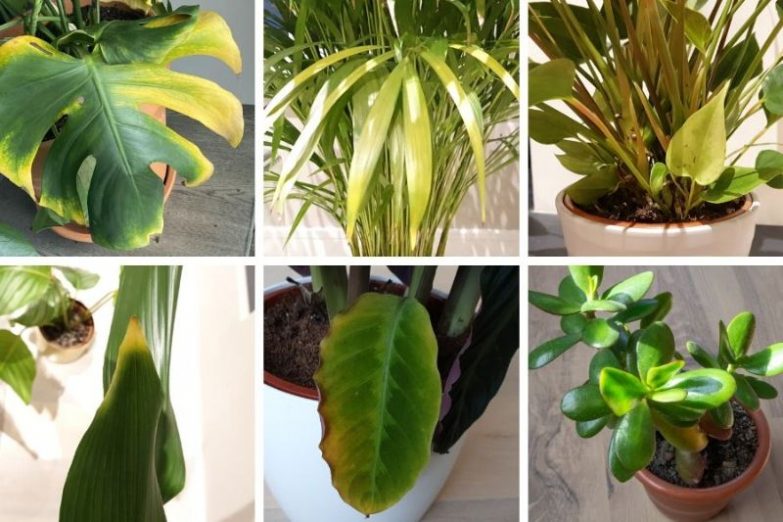Yellow leaves are a common sight on houseplants, but it can be difficult to know whether it is a sign of a problem with your cherished plant or not. This article is going to discuss the common causes of yellow leaves on houseplants, explaining how to identify each cause and help you fix any problems.
Causes of yellow leaves on houseplants: Yellow leaves can be caused by problems with watering, lighting, temperature, humidity, fertilizer, pests or disease. Houseplants can also develop yellow leaves due to natural leaf aging or acclimation. Identifying the cause is crucial to fixing your plant.
Read on and I’ll explain how to identify each cause of yellow leaves on your houseplants and show you how to fix your plant and prevent the problem recurring.
Causes Of Yellow Leaves On Houseplants
It’s always disheartening to see the leaves of your cherished houseplants turning yellow, and it isn’t always clear what is happening. It can be frustrating to see one of your houseplants looking less than its best. However, a lot of this frustration comes from not knowing what is happening.
Thankfully, if you look at the pattern of yellowing, the conditions the plant is in, and assess other aspects of care, it is usually possible to determine the cause and do something about it.
Although not all causes of yellowing leaves on houseplants are abnormal, it is often a sign that the plant is experiencing stress. Yellowing can be generalized, affecting all the leaves, or may just affect one area of your plant. Sometimes just the tips or edges of the leaves turn yellow. Other times there can be yellow spotting on the leaves. Each spot or leaf abnormality is a clue to help you determine the cause.
Thankfully, if you can identify the cause correctly, and take steps to fix the problem, your houseplant will grow new leaves and return to its former beauty.
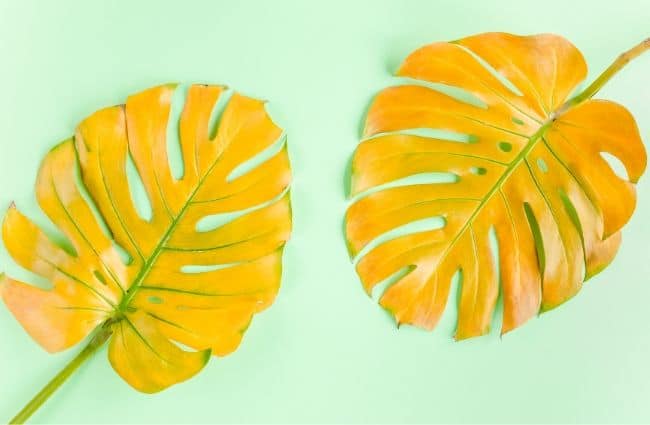
Overwatering
Overwatering is one of the most common houseplant problems, and is also the number one cause of generalized yellow leaves on houseplants. It tends to cause the lower leaves of most houseplants to turn yellow first, but a severe case can result in yellow leaves throughout the plant.
Your plant may also show signs of drooping and leaf drop, which may make you think underwatering is the problem. Examine your plant carefully, as it is critical to identify this issue quickly and take steps to fix your plant.
Yellow leaves on houseplants due to overwatering are caused by the effects of soggy soil on the roots. Although buried under the soil, roots need a continuous supply of oxygen to survive. This is normally facilitated by the air spaces between the potting medium, which allows air to freely enter the soil.
An overwatered houseplant develops soggy soil, with the air spaces being filled with water for a prolonged period of time. This prevents air getting in to the roots where it is needed.
If you see generalized yellowing of the leaves of your houseplant, check to see if the soil is soggy and examine the roots. Make sure there are no signs of soggy or rotten roots, or any rotten smells. If there are, you have found the cause of the yellow leaves.
Factors Causing Yellow Leaves Due To Overwatering
Interestingly, overwatering can be caused by many things other than just watering too often. Any factors that reduce drainage of the soil or reduce the amount of oxygen able to circulate through the soil can contribute to the problem.
1. Poorly Draining Pots
A pot with insufficient drainage holes, or without drainage holes at all will prevent excess water from draining out of the soil. This water will surround the roots and fill the air spaces, slowly suffocating your poor houseplant.
This can also happen if you forget to empty the drip tray or cachepot after watering. Most houseplants like to be watered thoroughly, but allow excess water to drain, and empty the drip tray after 10-15 minutes.
2. Poorly Draining Soil
Most houseplants do best in light, well-draining potting mix. The mix must have sufficient aeration so that it never becomes saturated when your plant is watered. See my article about houseplant soil to learn more.
Dense soil becomes waterlogged easily, resulting in poorly aerated, unhealthy roots that will soon be unable to meet the needs of the plant. Poorly draining soil also takes longer to dry out, further exacerbating the issue.
3. A Pot That Is Too Large
A pot that is too big for your plant will also cause symptoms of overwatering. After watering, a large volume of soil in an oversized pot will take a long time to dry out, leaving the roots sitting in soggy soil for an extended period of time.
4. Choice Of Plant
Lastly, your choice of houseplant has a big impact on the likelihood of overwatering being the cause of the yellow leaves. Succulents and cacti are adapted to deal with drought, but their Achilles heel is the overenthusiastic gardener with a watering can. Plants that prefer consistently moist soil are much more likely to survive moderate overwatering, but no plant likes to sit in soggy soil for too long.
So if you see generalized yellowing of the leaves of your houseplant, check the pot size, the soil you are using, think about the size of the pot in relation to the plant, and consider the type of plant you are growing.
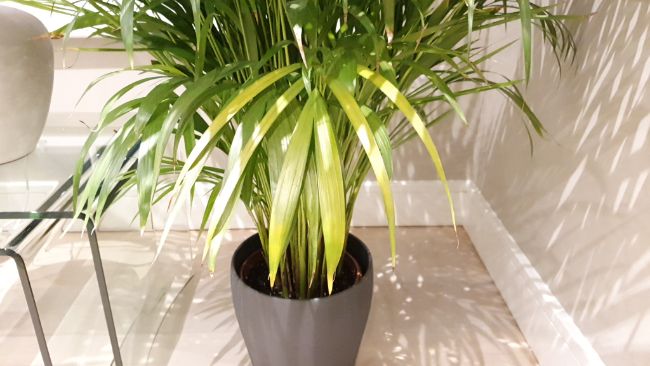
How To Fix An Overwatered Houseplant
Fixing an overwatered houseplant largely depends on how severe the problem is. If you have caught the problem early, and your plant just has some mild yellowing, simply let the soil dry out and water more sparingly in the future.
However, if the problem is more extensive, or there is any evidence of rotting roots, then you should take immediate action. Repot your plant, prune all affected roots, and give your plant some TLC to help it recover. Read my article about how to fix an overwatered plant and this article on how to identify, fix and prevent root rot to learn more.
Underwatering
Moving on to the opposite issue, underwatering can also cause yellow leaves. This typically happens when there is simply insufficient water to keep all the foliage on the plant alive. You can easily identify this problem by checking for drooping, curling and dropping of leaves. Lower leaves will likely become yellowed and curl. Leaf drop soon follows.
Younger foliage tends to wilt disproportionately compared to older foliage. You may see brown leaf tips or leaf edges too, and with prolonged underwatering. New leaves tend to be smaller and the overall growth of the plant will also be slower or stunted. Of course, the soil will also be very dry, so look for a combination of symptoms to identify the problem.
How To Fix An Underwatered Houseplant
The solution here isn’t too difficult. Just water your plant more often. It is usually best to water houseplants thoroughly when they need to be watered, allowing water to run right through the pot, soaking the soil. Then leave the plant to dry out to the degree preferred by the plant.
Remember that there are a number of factors that can contribute to underwatering. Temperature, airflow, humidity, growth rate, season, size of pot, and size of the plant compared to the pot can all have a big impact on water requirements.
It is often surprising how much the water requirements of houseplants change throughout the year. A plant that needs to be watered every 2-3 weeks during the winter, may need to be watered every few days during the summer when the temperatures are warmer and the plant is growing quickly.
Check whether your houseplants need water every day or two by feeling the soil, checking the foliage, testing the weight of the pot, to judge when more water is required. This article covers all of the ways I assess my plants to get watering just right.
Once you get a feel for how often your plants need to be watered, you may be able to reduce how often you need to check on them. If you find yourself waking in the night because you just had a feeling that one of your houseplants was thirsty, you may have gone too far.
Water Quality Problems Can Cause Yellow Leaves On Houseplants
The third watering issue that can cause yellow leaves on houseplants is water quality. Some houseplants can be quite sensitive about what kind of water you use to water them. Tap water usually contains chlorine and chloramines, as well as dissolved minerals, fluoride, and even heavy metals, which can cause yellow leaves on houseplants.
You may see yellow spots on the leaves, or brown tips or edges if your plant is struggling with the quality of the water. Most houseplants can handle tap water just fine, but Calatheas, Dracaenas, Bromeliads, and carnivorous plants can be quite sensitive.
I normally recommend starting out with tap water. If your houseplant starts getting yellow spots or brown tips/edges, exclude other issues, then switch to rainwater or filtered water and observe what happens. If new foliage is unaffected, then you should continue using filtered water or rainwater. If not, then the problem must lie elsewhere. Read this article to learn more about the impact of water quality on the health of your houseplants.
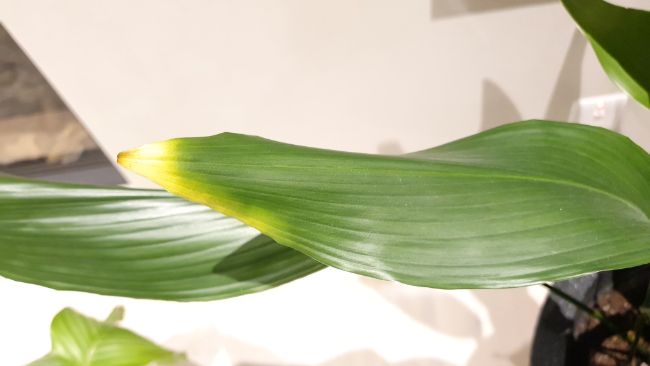
Low Humidity
A lot of indoor plants originate from tropical forests, where they live happily in the highly humid forest understory. While temperature and lighting are similar to our homes, humidity levels are worlds apart. Our homes tend to be much less humid than many houseplants ideally like, particularly in the winter, when we close out doors and windows and turn the heating on, which dries the air considerably.
Some houseplants are quite tolerant of low humidity levels, but others will curl, develop yellow leaves, leaves with brown crispy tips or edges in low humidity levels. I’m looking at you, Calatheas!
If humidity levels in your home are at least 40%, this should be sufficient for most plants. However, Calatheas, ferns, nerve plants, some palms, and pileas, for example, will soon develop foliage problems if humidity levels are not kept fairly high.
I would thoroughly recommend getting a digital hygrometer for your home, so you can monitor humidity levels. This will easily let you know when you need to take additional steps to improve humidity.
There are a range of measures you can take to increase humidity, including using a pebble tray, grouping your houseplants, placing your plants in more humid rooms, using a humidifier, and many more. I’ve covered all of these in more detail in this article.
Lighting Problems Causing Yellow Leaves On Houseplants
Both low light and high light can cause yellow leaves on houseplants but in very different ways.
High light or excess direct sunlight can cause scorching of leaves and increased transpiration, leading to leaf dehydration and death. This will cause yellow leaves to appear in sun-exposed parts of the plant. The plant is more likely to have crispy leaf edges or tips also.
Bear in mind that direct sunlight through a window is considerably less strong than direct sunight outside. This can cause issues if you move your plants from indoors to outside during the summer.
Very low light levels often cause the leaves of some houseplants to initially become darker green in color. The plant produces more chlorophyll and arranges it within the leaves to capture as much light as possible.
Eventually, the plant may be unable to sustain the same level of foliage, so leaves will start to turn yellow and may die. This often happens to older, lower leaves first. Just be careful not to confuse this pattern with the changes that happen in overwatering.
Some houseplants are much more tolerant of low lighting than others. Here are some of my favorite houseplants that are more suitable for low light.
Acclimation
After you bring your houseplant home, it will be exposed to conditions quite different from those it was used to in the shop or nursery. Most plant nurseries grow houseplants in perfect conditions, with optimal light, water, humidity, and temperatures.
Our homes are unlikely to provide such well-optimized conditions, and so the plant will go through a period of acclimation. This will likely involve some foliage yellowing and dropping.
If this happens within the first few weeks, and the conditions in your home are reasonable for the plant, then don’t worry too much. Things should stabilize after a few months, new growth will develop, and the plant will look healthy once more.
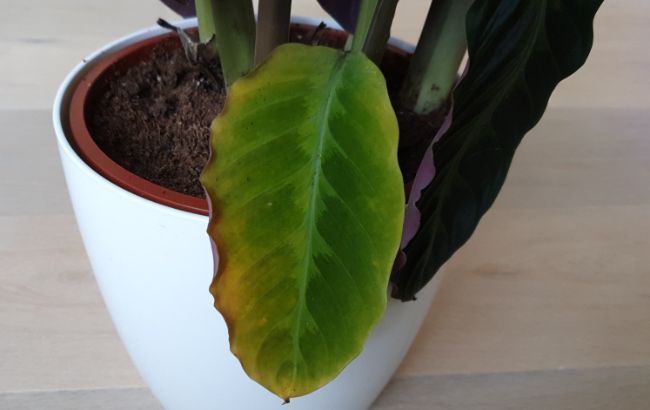
Temperature Extremes
Another source of stress that can cause yellow leaves on houseplants is temperature stress. Most houseplants do best in temperatures between 62ºF (16ºC) and 81ºF (27 °C). Once the temperature strays too far outside this range, your houseplant may start experiencing stress. This can lead to generally yellowing foliage followed by leaf drop. The exact temperature tolerance will vary depending on the plant.
Rapid changes in temperature are often worse for houseplants than gradual changes. Watch out for cold or hot drafts that may shock your houseplant, causing yellowing foliage within a few days.
Sometimes your houseplants can be exposed to temperature extremes in the store or during delivery to your home. It is always worth checking with the retailer to ensure that conditions on display have been suitable. If you buy online, consider how your plant will be packaged, how far it will travel, and the time of year. All these factors can affect the risk of temperature stress during transit.
Fertilizer Issues Causing Yellow Leaves On Houseplants
Overfeeding is much more likely to cause yellow leaves on houseplants than underfeeding. Some mineral toxicities will produce distinct patterns of leaf spotting or yellowing, but these are generally unreliable signs.
Remember that fertilizer is not food or medicine for your plants. Its role is to support growth by delivering essential nutrients that may be in short supply in the potting medium. A little goes a long way! Read my guide to fertilizing houseplants to learn more.
If you see yellow leaves on your houseplants after fertilizing a little too often, stop, flush the soil and wait a few months before resuming at a much more conservative rate.
How To Flush The Soil Of Excess Fertilizer Salts
Fertilizer salts tend to build up in the soil over time, causing yellow leaves on houseplants and other signs of nutrient toxicity. If you water small amounts at a time, excess salts are never washed out through the drainage holes.
To avoid fertilizer build-up, It is best to water most houseplants thoroughly, allowing water to drain freely out of the drainage holes.
It is also a good idea to flush the soil more thoroughly a few times per year. I take my plants to the sink to do this and let the water run out of the drainage holes for 1-2 minutes, soaking the soil completely. This dissolves the excess salts, washing them out of the pot, and reducing the risk of build-up in the soil. Just remember to let the soil dry out an appropriate amount before watering again.
Pests And Diseases
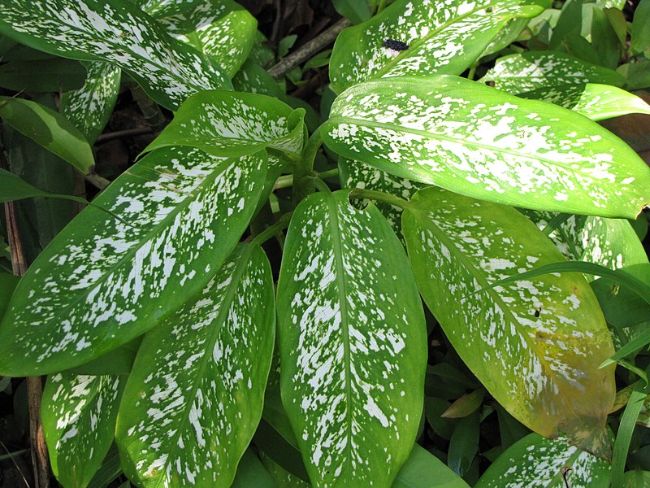
Common houseplant pests like spider mites, aphids, mealybugs, and scale infestations can cause yellow leaves on houseplants or stunted foliage. Sap sucking insects will cause yellow spots on the leaves. Most pests will be visible on your plants if you look closely enough, or will leave telltale signs of their presence.
Inspect your houseplants closely on a regular basis to check for pests. Don’t forget to look under leaves, on stems and even in the soil. If you identify a pest, quarantine your plant, and refer to my houseplant pest guide to identify the culprit and get rid of it.
Diseases can also cause yellow leaves on houseplants. The pattern of yellowing will depend on how the disease is attacking the plant. Pathogens causing root rot will cause wilting and generalized yellowing. Many other diseases cause leaf spots, which can be yellow, brown or black. Read my article about common houseplant diseases to learn more about these.
Aging Foliage
If you see the lower leaves on your houseplants turning yellow one by one and dropping, this is often a sign of plant aging. As long as the rest of the plant looks healthy, then there is nothing to worry about.
Feel free to prune these yellow leaves, or let then drop naturally and then remove them from around the pot.

